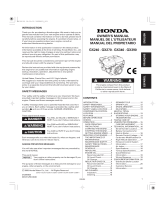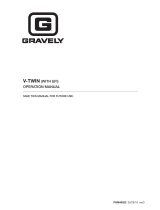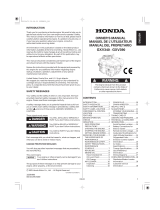
11
CONSUMER INFORMATION
Honda Publications
These publications will give you additional information for maintaining
and repairing you engine.You may order them from an authorized
Honda engine servicing dealer.
Distributor’s Limited Warranty
(1) Honda GXV series general purpose engines have a 3 months warranty period when
installed on concession type vehicles.
To Qualify for this Warranty:
The Honda general purpose engine must be purchased from a Honda general purpose
engine dealer or distributor authorized to sell that product in the United States, Puerto Rico,
or the U.S. Virgin Islands. This limited warranty applies to first retail purchaser and each
subsequent owner during the applicable warranty time period.
What American Honda Will Repair or Replace Under Warranty:
American Honda will repair or replace, at its option, any part that is proven to be defective
in material or workmanship under normal use during the applicable warranty time period.
Warranty repairs and replacements will be made without charge for parts or labor. Anything
replaced under warranty becomes the property of American Honda Motor Company, Inc.
All parts replaced under warranty will be considered as part of the original product and any
warranty on those parts will expire coincident with the original product warranty.
To Obtain Warranty Service:
You must take your Honda general purpose engine, or the equipment in which it is
installed, together with proof of original retail purchase date, at your expense, to a Honda
engine dealer or distributor authorized to sell that product in the United States, Puerto Rico,
or the U.S. Virgin Islands, during their normal business hours. Many Honda engine dealers
and distributors are listed in the yellow pages of the telephone directory under gasoline
engines, lawn & garden equipment & supplies, etc.
If you are unable to obtain warranty service, or are dissatisfied with the warranty service
you receive, take the following steps: First contact the owner of the dealership or distributor
involved. Normally this should resolve the problem. However, if you are dissatisfied with
the decision made by the dealership's management, contact the Honda Regional Engine
Distributor for your area. You can find their name, address, and phone number using the
dealer/distributor locator on our website at (www.honda-engines.com) or by calling 1-800-
426-7701. If you are still dissatisfied after speaking with the Regional Engine Distributor,
you may contact the Honda Power Equipment Customer Relations Department of
American Honda Motor Co., Inc. Refer to page 12 for contact information.
Exclusions:
THIS WARRANTY DOES NOT EXTEND TO PARTS AFFECTED OR DAMAGED BY THE
PRODUCT IN WHICH THE ENGINE IS INSTALLED, OR BY ACCIDENT AND/OR
COLLISION, MISUSE, NEGLECT, PARTS WORN BEYOND SERVICE LIMITS DUE TO
NORMAL WEAR/NORMAL SERVICE LIFE, PARTS AFFECTED OR DAMAGED BY THE
CONVERSION TO OR USE OF FUEL OTHER THAN THE FUEL(S) WHICH THE
ENGINE IS ORIGINALLY MANUFACTURED TO USE, POOR OPERATION RELATED TO
FUEL CONTAMINATION OR FUEL QUALITY, PARTS DAMAGED BY FUEL
CONTAMINATION, THE INCORPORATION OF, OR USE OF, UNSUITABLE
ATTACHMENTS OR PARTS, THE UNAUTHORIZED ALTERATION OF ANY PART OR
ANY CAUSES OTHER THAN DEFECTS IN MATERIAL OR WORKMANSHIP OF THE
ENGINE. USE OF THE HONDA GENERAL PURPOSE ENGINE FOR RACING OR
COMPETITION WILL VOID THIS WARRANTY.
Disclaimer of Consequential Damage and Limitation of Implied Warranties:
AMERICAN HONDA DISCLAIMS ANY RESPONSIBILITY FOR LOSS OF TIME OR USE
OF THE ENGINE, OR THE EQUIPMENT IN WHICH THE ENGINE IS INSTALLED,
TRANSPORTATION, COMMERCIAL LOSS, OR ANY OTHER INCIDENTAL OR
CONSEQUENTIAL DAMAGE. ANY IMPLIED WARRANTIES ARE LIMITED TO THE
DURATION OF THIS WRITTEN LIMITED WARRANTY. Some states do not allow
limitations on how long an implied warranty lasts and/or do not allow the exclusion or
limitation of incidental or consequential damages, so the above exclusions and limitations
may not apply to you.
This warranty gives you specific legal rights, and you may also have other rights which vary
from state to state.
Emission Control System Warranty
Your new Honda Power Equipment engine complies with both the U.S. EPA and State of
California emission regulations. American Honda provides the same emission warranty
coverage for engines sold in all 50 states.
Your Warranty Rights And Obligations:
California
The California Air Resources Board and American Honda Motor Co., Inc. are pleased to
explain the emission control system warranty on your Honda Power Equipment engine. In
California, new utility and lawn and garden equipment engines must be designed, built and
equipped to meet the State's stringent anti-smog standards.
Other States
In other areas of the United States your engine must be designed, built, and equipped to
meet the U.S. EPA emission standards for spark-ignited engines at or below 19 kilowatts.
All States
American Honda Motor Co., Inc. must warrant the emission control system on your power
equipment engine for the period of time listed below provided there has been no abuse,
neglect or improper maintenance of your power equipment engine. Where a warrantable
condition exists, American Honda Motor Co., Inc. will repair your power equipment engine
at no cost to you including diagnosis, parts and labor.
Your emission control system may include such parts as the carburetor or fuel injection
system, the ignition system, and catalytic converter. Also included may be hoses,
connectors and other emission-related assemblies.
Manufacturer's Warranty Coverage:
The 1995 and later power equipment engines are warranted for two years. If any emission-
related part on your engine is defective, the part will be repaired or replaced by American
Honda Motor Co., Inc.
Owner's Warranty Responsibility:
As the power equipment engine owner, you are responsible for the performance of the
required maintenance listed in your owner's manual. American Honda Motor Co., Inc.
recommends that you retain all receipts covering maintenance on your power equipment
engine, but American Honda Motor Co., Inc. cannot deny warranty coverage solely for the
lack of receipts or for your failure to ensure the performance of all scheduled maintenance.
As the power equipment engine owner, you should however be aware that American
Honda Motor Co., Inc. may deny you warranty coverage if your power equipment engine or
a part has failed due to abuse, neglect, improper maintenance, or unapproved
modifications.
You are responsible for presenting your power equipment engine to a Honda Power
Equipment dealer as soon as a problem exists. The warranty repairs should be completed
in a reasonable amount of time, not to exceed 30 days.
If you have any questions regarding your warranty rights and responsibilities, you should
write or call the Honda Power Equipment Customer Relations Department. Refer to
page 12 for contact information.
Warranty Coverage:
Honda power equipment engines manufactured after January 1, 1995 and sold in the State
of California, and U.S. EPA certified engines manufactured on or after September 1, 1996
and sold in all of the United States, are covered by this warranty for a period of two years
from the date of delivery to the original retail purchaser. This warranty is transferable to
each subsequent purchaser for the duration of the warranty period.
Warranty repairs will be made without charge for diagnosis, parts or labor. All defective
parts replaced under this warranty become the property of American Honda Motor Co., Inc.
A list of warranted parts is on the reverse side of this warranty statement. Normal
maintenance items, such as spark plugs and filters, that are on the warranted parts list are
warranted up to their required replacement interval only.
American Honda Motor Co., Inc. is also liable for damages to other engine components
caused by a failure of any warranted part during the warranty period.
Only Honda approved replacement parts may be used in the performance of any warranty
repairs and must be provided without charge to the owner. The use of replacement parts
not equivalent to the original parts may impair the effectiveness of your engine emission
control system. If such a replacement part is used in the repair or maintenance of your
engine, and an authorized Honda dealer determines it is defective or causes a failure of a
warranted part, your claim for repair of your engine may be denied. If the part in question is
not related to the reason your engine requires repair, your claim will not be denied.
To Obtain Warranty Service:
You must take your Honda Power Equipment engine or the product on which it is installed,
along with your warranty registration card or other proof of original purchase date, at your
expense, to any Honda Power Equipment dealer who is authorized by American Honda
Motor Co., Inc. to sell and service that Honda product during his normal business hours.
Claims for repair or adjustment found to be caused solely by defects in material or
workmanship will not be denied because the engine was not properly maintained and
used.
If you are unable to obtain warranty service, or are dissatisfied with the warranty service
you receive, see To Obtain Warranty Service on page 12.
Shop Manual This manual covers complete maintenance and overhaul
procedures. It is intended to be used by a skilled
technician.
Parts Catalog This manual provides complete, illustrated parts lists.
PRODUCTS COVERED BY THIS
WARRANTY:
LENGTH OF WARRANTY:
(FROM DATE OF ORIGINAL
PURCHASE)
PRODUCT APPLICATIONS NONCOMMERCIAL/
NONRENTAL
COMMERCIAL/
RENTAL
GXV Series
Engines
ALL (1) 24 months 24 months

















